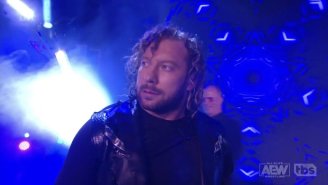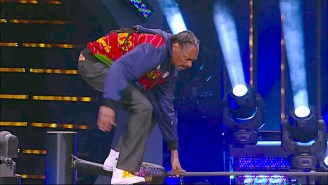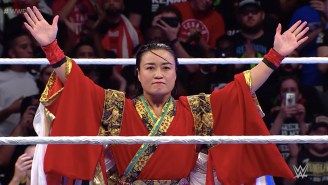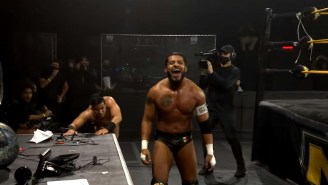Chikara Pro’s King of Trios 2012. For people who were there, it’s a hard weekend to write about. I’ve tried once and barely scratched the surface of everything that weekend was, and everything I took away from it. I made several friends, but also came away with a best friend. Without that weekend I would have never been encouraged to start writing again, and you definitely wouldn’t be reading this now. That weekend solidified my diehard support for most of the wrestlers of Chikara, and reaffirmed that everything I want from pro wrestling can exist, and it can be executed beautifully. I got to see dudes from Osaka Pro, ladies from JWP, joshi legend Manami Toyota in person in real life, and fall in love with Tsubasa Kuragaki, the number one hoss of my heart. I felt the spirit of community that independent wrestling creates, and thrived in it. I also saw the very first live match that was so good it brought me to tears.
This isn’t the story of King of Trios 2012. This is the journey of the Sendai Girls – Meiko Satomura and the Jumonji Sisters – and how they went from opening match underdogs to some of the most beloved wrestlers to ever step foot in a Chikara ring.
September 14th, 2012: The Colony vs. The Sendai Girls, King of Trios Night 1 Chikara Pro
The Sendai Girls are a perfect example of what it means to be completely dedicated to Professional Wrestling. Sachiko and Chisako came into CHIKARA with huge shoes to fill, being presented alongside one of the greatest wrestlers ever, their trainer Meiko Satomura. They have never once failed to fill those shoes and win over every single person in the building. Satomura should be an inspiration to every wrestler, no matter how much experience they have. She is a class act and a veteran that gives 100% every time she wrestles. The match we had at King Of Trios 2012 is one of my favorite CHIKARA memories. Everyone in CHIKARA was proud to have all three wrestlers in the tournament. – Silver Ant
Going into the weekend, I wasn’t the self-admitted indie wrestling-obsessed blogger you all know me to be today. I was already a Chikara fan, but the two shows I had been two belied the kind of experience that makes Chikara special, so I was still on the outskirts. Still just a casual indie fan. I was lucky enough to meet and have a legitimate fangirl meltdown over Sarah Del Rey at a show in Strathroy, ON, but also spend a good deal of time talking to Jakob Hammermeier at the same show. In fact, it was Jakob remembering my name after so many months when I approached his table at King of Trios that could really be considered the spark that ignited my passion for Chikara, nay independent wrestling as a whole. From the get go that weekend felt special, and if I were to take the opening match as any indication, it was going to be full of some incredible wrestling matches.
Sendai Girls’ Pro Wrestling was founded by Meiko Satomura and Jinsei Shinzaki in 2005. After months of training, four girls debuted in the first Sendai show against a handful of legends on the joshi scene. This group included current member Sendai Sachiko, who would go on to partner with her sister Dash Chisako. Both of these ladies would accompany Satomura to the US earlier in 2012 for Chikara Pro’s Anniversario weekend, but despite having wrestled in Chikara before, there wasn’t an immediate crowd reaction during their entrance. Realistically, there were a number of people there, myself included, who had no idea what to expect.
The Colony, to take a moment for those unfamiliar, are legitimate fan favourites. They were the defending King of Trios champions, and one could have very easily assumed that this would be a quick first-round knockout for them. I always call the Colony a Gateway Tag-Team. If you’re introducing someone to Chikara, there’s a 100% chance you can find a Colony match they’ll love. At the same time, the Colony are a popular tool for detractors of Chikara. Just how can a bunch of guys dressed like ants be serious about wrestling? Spoiler alert: they are the most serious. Green – now Silver – Ant, is secretly one of the best independent wrestlers on the scene. Fire Ant has been so good for so long you almost start to take his talent for granted. Soldier Ant is incredibly versatile in any style and was my very favourite for a long time (my favourite now is all of them). Colony classicists will point you to matches with these three, but this was not the trio presented. Without going into too much detail, Soldier Ant had been traded, if you will, to a team of invading bad guy ants, and in return they got big blue bruiser in AssailAnt. AssailAnt was still a Rudo (or bad guy) working on a team of pure Technicos (good guys). Green and Fire were still trying to do their best to not necessarily work with, but work around their new partner and his tendencies to act and wrestle like a real jerk, but still act as one fully functioning cohesive unit.
Right off the bat, referee extraordinaire Bryce Remsberg and my beloved Jakob note on commentary that Chikara knows no gender divisions, no species divisions, and no size divisions. It’s all about talent. That’s an important distinction to make as we go through these three days. Technicos to a fault, Fire and Green Ant respectively treat the Sendai girls like they would any other opponent. There’s no “oh, I can’t hit a girl,” or “pfffft, what can those girls do?” No one on Team Sendai has to earn the respect of the Colony, it’s automatically granted because they’re wrestlers in a wrestling ring booked to wrestle.
There’s an overarching theme of equalizing the sexes throughout the weekend. Sometimes it’s obvious, as when Tsubasa Kuragaki took on Matt Classic – an old-fashioned luchador with outmoded ideas towards intergender wrestling – refused to participate in his match, and in the end was bested by a woman just as strong as he is. Sometimes it’s more subtle. During the opening contest, Green Ant picks up both Dash and Sachiko and bodyslams them both at the same time. Despite the small stature of the Jumonji sisters, it’s still a great feat of strength for anyone. Later, Tsubasa Kuragaki of Team JWP and My Heart Forever puts both Kaori Yoneyama and Manami Toyota into a double Argentine backbreaker. Two wrestlers at once? Feats of strength? Looking kinda super badass? Gender is the last thing that matters.
The win over the Colony wasn’t without shenanigans. Tensions between the transplanted AssailAnt and Green Ant reached a boiling point, with Green Ant headbutting his rudo teammate. This caused enough of a distraction for Meiko Satomura to sneak in and hit Green with a pele kick (Satomura has the best one. The BEST one), then isolate him by delivering a roundhouse kick to AssailAnt that knocked both he and Fire out of the ring. Left on his own Green fell victim to Sachiko’s moonsault, then Dash’s frog splash. A finish that involves a distraction, but still allows the winners to look strong as anything? The novelty of it all!
And with that the defending Kings of Trios were sent packing. The Sendai Girls matched them blow for blow, challenged the fast pace set by Green and Fire Ant, and showed that big goon AssailAnt who’s boss. People in the crowd who knew what to expect clapped and cheered as when the team first came out, but the chorus of appreciative cheers had grown enough to fill the room. The Sendai Girls had set the bar, and it was up to the rest of the locker room to match it.
September 15th, 2012: Jigsaw, Mike Quackenbush, and Manami Toyota vs. The Sendai Girls, King of Trios Night Chikara Pro
The tone of Day 2 was different. Where the Colony (or at least two of them) afforded the same respect they’d afford anyone who stepped into the ring with them, the Sendai Girls would now have to face Jigsaw and two titans of their fields, and the different kind respect – almost reverence – that comes with it. Mike Quackenbush is not only the founder of Chikara, but can be held responsible for not just his own incredible talent and career, but the training of so many greats on the independent scene. Few are held in such a high regard as when he is in a Chikara ring. Manami Toyota is a joshi legend, and to some the greatest pro wrestler of all time. Her presence removes any possible inference of a gender imbalance, and a whole new story begins to unfold.
On commentary, it’s consistently pointed out that by comparison, the Sendai Girls, specifically Dash and Sachiko, just don’t have a lot of relative experience. And that’s fair. When Satomura (the veteran) is in the ring one on one with Quack, there’s a mutual understanding and recognition of the dedication and talent of the other. She’s poised, collected, the clear leader of the group.
Dash and Sachiko, while not rookies by any means, still show their youthful exuberance in moves that some would call rash. Where Satomura calm and composed, trying to take apart her opponents with precision, the other two throw everything they possibly can at the legends. Sometimes though, they pay the price. At one point, Sachiko does a missile dropkick to Quack, only to be caught from behind with another missile dropkick from Manami Toyota. You can’t bring that to Manami Toyota’s doorstep without getting schooled in return. And she doesn’t just kick her once, she does it again, and again, and then kicks her again because she’s is Manami Toyota, and she will murderboot any tiny baby joshi who get in her way.
Early on in the match, Manami takes out all three Sendai Girls at once, asserting her dominance over the upstart trio. Throughout the match, each of them put all they have into getting past what could easily be considered a final boss in any video game simile. But it’s not until they work together, directed by Maiko Satomura, that they can overcome the years of experience facing them down from the other corner. It’s a game of divide and conquer: isolate the others to the outside while rotating finishers to the one left in the ring. Satomura neutralizes Toyota with an outside dive, calling back to the first point in the match where the other team fully asserted their dominance. It’s such a smart match from start to finish, and it sums up perfectly everything that a pro-wrestling match should be.
That is, until Night 3.
Meiko Satomura is the best professional wrestler on the planet. – Drew Gulak
September 16th, 2012: Team Ring of Honor vs. The Sendai Girls, King of Trios Night 3 Chikara Pro
To this point, the Sendai Girls had overcome fan favourites and ring legends. They came out, unknown to most, and with indomitable spirit and the biggest hearts in the building made every single person in the audience fall in love with them.
Team ROH did not. The Young Bucks have always been smarmy little jerks, and that’s a lot of the reason they work so well. They’re never better than when they’re acting like conceited pricks, too-sweeting and crotch-chopping and superkicking anyone and everyone. It’s the perfect example of finding what works, cranking it to 11, and making everyone love to hate you. Mike Bennett and Maria joined the Young Bucks, and instead of warming hearts and rallying people behind them, Team Ring of Honor did everything they could to cheat, disrespect, and humiliate their opponents. By the time these two met, the crowd had reached almost a fever pitch over both teams. If you ever need a crash course in face-heel dynamics, this is it.
I always find this match so tough to write about, because it is, truly, everything that is good about professional wrestling. It’s the kind of match that’s hard to recount because it’s not just the sum of it’s kicks and suplexes, it’s a fully realised story playing out in front of you. This match is the very definition of the transportative nature of wrestling. I watched and I cheered and by the end of it I had gotten so wrapped up in the match that all I could do was well up with tears, completely overwhelmed. I loved wrestling, but I didn’t know it could be like this. I didn’t know it could feel like this.
The match isn’t just a one-dimensional face vs. heel battle. It has everything: moments of comedy, feats of strength, high spots, submissions, Meiko Satomura’s kicks that make me feel things. I once described her pele kick by saying “If I were AJ Styles and I saw that, I would immediately retire it from my repertoire and feel ashamed I had ever attempted it in the first place.” I stand by that.
The match is also important when it comes to how intergender matches should work. A lot of the time you get these dumb matches where a false sense of empowerment is created. Chikara, even if it’s my happy place, is not absent from these criticisms, and do have their share of what is usually referred to as “The Heidi Lovelace Special.” It’s the idea that a woman enters the ring, is not seen as a threat, is mocked or dismissed, and then has to fight back and prove herself worthy of getting into the ring. See, the trope of a male wrestler thinking that a woman can’t wrestle only to get his comeuppance seems like a positive thing, but it’s not. It’s not some satirical social commentary on real-life views, it just keeps hammering the point home that women are viewed as a lesser. It’s incredibly frustrating, but understanding how prevalent that type of match is vital to understanding why the context of this match is so important.
The Young Bucks don’t respect the Sendai Girls because they’re girls. They’re rudos, that’s fair. They also don’t respect the Sendai Girls because they don’t respect anybody. Their initial dismissal can have gendered implications, but the greater idea is that it doesn’t matter who stepped into the ring with them – they were still going to be assholes. They could have met up with the Spectral Envoy and made fun of Hallowicked and Frightmare for being pumpkins. They could have met up with FIST and made fun of Icarus’s back tattoo and Johnny Gargano’s constant leg slaps (though that would be hugely hypocritical, really). The merits of the characters in the ring are served by the simple idea that women are lesser, but it’s not central to anything that Team ROH is doing. Team ROH hates everyone and thinks Chikara is dumb. The Sendai Girls faced the odds, and became beloved after two matches.
Bennett and the Young Bucks underestimated the Sendai Girls, but their cockiness and arrogance would have seen them underestimate anyone they got matched up with in the tournament. They just happened to have the misfortune of meeting up with three joshi wrestlers who forced them to give it all they had to battle through to the final. And that’s just what it was: a battle. There’s this beautiful spot where, as they had isolated their opponents before, Meiko Satomura finds herself alone with Bennett and the Bucks after Maria once again distracts the referee. Satomura knows what this means; she’s done it to others in the tournament, and now her strategy has turned against her. But she fights. She goes on. She takes on all three at once because that’s the kind of will and determination that has gotten her this far. She looks like she can do it, but then is met with a triple superkick. Superkicks are de rigeur in a Bucks match, but this one…this one was heartbreaking.
The Sendai Girls would not be victorious that day. Team ROH would go on to face The Spectral Envoy in the final, and give me one of my most treasured wrestling memories to date. But this, man. This is it. This is the best match out of the whole weekend, and for me, one of the best matches I’ve ever seen live. They proved that not just one but three female wrestlers could have as much skill and as much heart as anyone in the ring.
They are no longer underdogs. They are no longer be virtual unknowns. They are the Sendai Girls, and this match is my heart.






